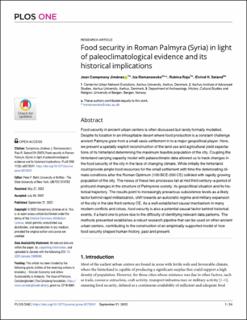| dc.contributor.author | Campmany Jiménez, Joan | |
| dc.contributor.author | Romanowska, Iza | |
| dc.contributor.author | Raja, Rubina | |
| dc.contributor.author | Seland, Eivind Heldaas | |
| dc.date.accessioned | 2022-09-27T10:41:42Z | |
| dc.date.available | 2022-09-27T10:41:42Z | |
| dc.date.created | 2022-09-23T08:35:56Z | |
| dc.date.issued | 2022 | |
| dc.identifier.issn | 1932-6203 | |
| dc.identifier.uri | https://hdl.handle.net/11250/3021716 | |
| dc.description.abstract | Food security in ancient urban centers is often discussed but rarely formally modelled. Despite its location in an inhospitable desert where food production is a constant challenge ancient Palmyra grew from a small oasis settlement in to a major geopolitical player. Here, we present a spatially explicit reconstruction of the land use and agricultural yield expectations of its hinterland determining the maximum feasible population of the city. Coupling the hinterland carrying capacity model with palaeoclimatic data allowed us to track changes in the food security of the city in the face of changing climate. While initially the hinterland could provide ample food resources for the small settlement with time the deteriorating climate conditions after the Roman Optimum (100 BCE-200 CE) collided with rapidly growing population of the city. The nexus of these two processes fall at mid third century–a period of profound changes in the structure of Palmyrene society, its geopolitical situation and its historical trajectory. The results point to increasingly precarious subsistence levels as a likely factor behind rapid militarization, shift towards an autocratic regime and military expansion of the city in the late third century CE. As a well-established causal mechanism in many modern conflicts and crises, food security is also a potential causal factor behind historical events, if a hard one to prove due to the difficulty of identifying relevant data patterns. The methods presented establishes a robust research pipeline that can be used on other ancient urban centers, contributing to the construction of an empirically supported model of how food security shaped human history, past and present. | en_US |
| dc.language.iso | eng | en_US |
| dc.publisher | PLOS | en_US |
| dc.rights | Navngivelse 4.0 Internasjonal | * |
| dc.rights.uri | http://creativecommons.org/licenses/by/4.0/deed.no | * |
| dc.title | Food security in Roman Palmyra (Syria) in light of paleoclimatological evidence and its historical implications | en_US |
| dc.type | Journal article | en_US |
| dc.type | Peer reviewed | en_US |
| dc.description.version | publishedVersion | en_US |
| dc.rights.holder | Copyright 2022 The Author(s) | en_US |
| dc.source.articlenumber | e0273241 | en_US |
| cristin.ispublished | true | |
| cristin.fulltext | original | |
| cristin.qualitycode | 1 | |
| dc.identifier.doi | https://doi.org/10.1371/journal.pone.0273241 | |
| dc.identifier.cristin | 2054590 | |
| dc.source.journal | PLOS ONE | en_US |
| dc.identifier.citation | PLOS ONE. 2022, 17(9), e0273241. | en_US |
| dc.source.volume | 17 | en_US |
| dc.source.issue | 9 | en_US |

